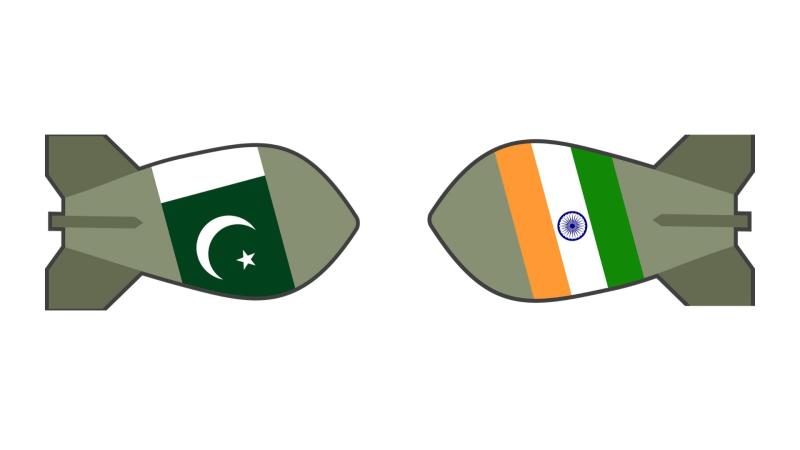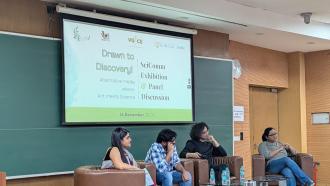
Research shows a regional nuclear conflict could affect global crop yields and food supply
Since Independence, India and Pakistan have been at loggerheads over Kashmir, a region both countries claim to be theirs. The two countries have made several attempts to find a 'solution' to the Kashmir problem, including three major wars, mediation by the United Nations and other countries, and bilateral dialogues. Yet, the 'solution' has been elusive, leading to the two countries stockpiling nuclear armaments. In recent years, the tension has escalated, pushing them to the brink of a full-blown nuclear war. What would be the consequence of such a nuclear war, if it were to happen?
In a new study, an international team of researchers have analysed the global consequence of a regional nuclear war between India and Pakistan, which possess less than 1% of the world's nuclear arsenal. The study, published in the Proceedings of the National Science Academy (PNAS), looked at the impact of the conflict on the climate, agricultural production and yields and the global food supply. The study found that a nuclear war would result in an average loss of 11% in the production of staples globally for five years after the conflict.
"There is a new global nuclear arms race going on, and many countries are investing in renewing their arsenals. In South Asia, increased tensions between Pakistan and India and also China and North Korea, have fuelled a nuclear arms race," says Dr Jonas Jägermeyr, the corresponding author of the study. "However, we don't have a clear understanding of the indirect effects of a regional nuclear war on food security, not in the countries involved in the war, but for all other countries globally," he points out, talking about the motivation behind this study.
Catastrophic events like large volcanic eruptions, like those witnessed in Laki and Tambora, or wildfires, or bombings like that in Hiroshima, result in emissions of massive amounts of soot, or burnt carbon, into the atmosphere. This plume of smoke absorbs the Sun's radiation and blocks it from reaching the Earth's surface. As a result, the surface temperature suddenly drops, and the rainfall pattern gets perturbed, leading to widespread famines, crop failures and economic hardships.
Based on the nuclear arsenals of India and Pakistan, previous studies have estimated that about 5 Teragram (5,000,000,000 kilograms) of soot would be released into the atmosphere if they are used.
"Given the increasing number and size of nuclear weapons in India and Pakistan, this is considered a conservative estimate," says Dr Jägermeyr. This soot, the study finds, is detrimental to the world's agriculture and could affect our food systems and food availability. "The situation would be similar to the food availability constraints and panic buying we are currently seeing due to the coronavirus pandemic. Only that, the empty shelves that are currently commonplace, will be much severe and lasting for multiple years," he quips.
A massive breadbasket failure in sight
The researchers used historical data to predict the climatic changes resulting from the soot. They also used six crop-models to simulate the global calorific production and crop yields of four major staples in the world—maize, wheat, rice and soybean—for five years after the conflict. Besides, they also analysed the implications on the global food trade during this period, considering country-wise food reserves and possible shortfalls in import and export of food supply.
The study found that a 5Tg of soot emission would be catastrophic for the world. "As soon as soot emissions reach the stratosphere, implications unfold globally," warns Dr Jägermeyr. The global water cycle would be perturbed for at least a decade. The surface temperature would fall by 1.8oC, and the rainfall would decrease by 7.9%. The reduction ofthe solar radiation reaching the Earth would produce the coldest average temperature never seen in the last 1000 years. The soot that gets deposited at higher stratospheric layers of the atmosphere would also result in ozone depletion, leading to increased UV radiations on Earth.
The resulting climate changes would reduce the total global calorific production of the world's staple by about 11% annually, for five years after the war, finds the study. The maximum losses are recorded in the fourth year. Maize, which constitutes about 35% of the global cereal production and trade, was projected to have an annual production loss of 12.6%, while wheat had a 10.9% loss. The most affected crop was soybean with production losses as much as 16.8%. Rice recorded the least of the projected loss, with just 3.4%. These calculations exclude the damage resulting from total crop failure in India and Pakistan. If included, the global loss would surge to about 19%, say the researchers.
Interestingly, the developed world would face the most considerable total crops losses than tropical countries in the event of a nuclear conflict between India and Pakistan. Most of the impacts on the crop yield are found to be in countries 30o North of the equator as the temperature would fall by more than 3oC in these regions. However, due to changes in the rainfall pattern, some countries in Central America and the Mediterranean could see some gains.
The study projects that the loss in food production has repercussions for global food trade, affecting about two billion people who would face a shortage of food supply by as much as 30%. While the crop demands for the first and second years after the conflict would be filled up by reserve supplies in various countries, sustained crop losses during the following years would result in global food shortages. Countries like Canada, Mexico, Poland would experience substantial reductions in the availability of maize and wheat, while those that rely on food imports, like Libya, Somalia, Rwanda and others, which are already food insecure, would be the most affected. The food shortage could further result in inflated food prices, leading to massive inequalities and social unrest, especially in developing countries.
"There is no such thing as a confined nuclear conflict," states Dr Jägermeyr, as the study findings show that the implications of such a war would be global. It could hit food production the hardest in developed countries like the USA, France, Russia, and China, which, ironically, possess the bulk of the global nuclear arsenal. "Our findings hold true for any other nuclear conflict with similar soot emissions. The conclusions are that more people might die from food shortages than due to the direct effects of the war," he cautions.
Global cooling worse than global warming
The study shows how global cooling, due to massive fires, can be as disastrous as global warming.
"While we usually study global warming, the question about how sudden cooling would affect crop production and food systems is unresolved," says Dr Jägermeyr, who is a climate scientist specialising in studying the impacts of climate change on global food production. "This study is the first to show that sudden cooling is more harmful to global crop production than global warming," he says.
But why is global cooling, brought about by massive fires, so bad? The abrupt drop in temperature provides little or no time to switch to other crops, roll out new seeds at scale, develop cold-resistant varieties or move croplands to more suitable areas.
"While global warming negatively affects mostly the tropics, global cooling affects the breadbaskets of the world," explains Dr Jägermeyr. Besides, the higher carbon dioxide concentrations in the air could have a beneficial effect on crop growth, offsetting some of the adverse impacts of climate change. "Global cooling would not have these beneficial effects," he signs off.
This article has been run past the researchers, whose work is covered, to ensure accuracy.






